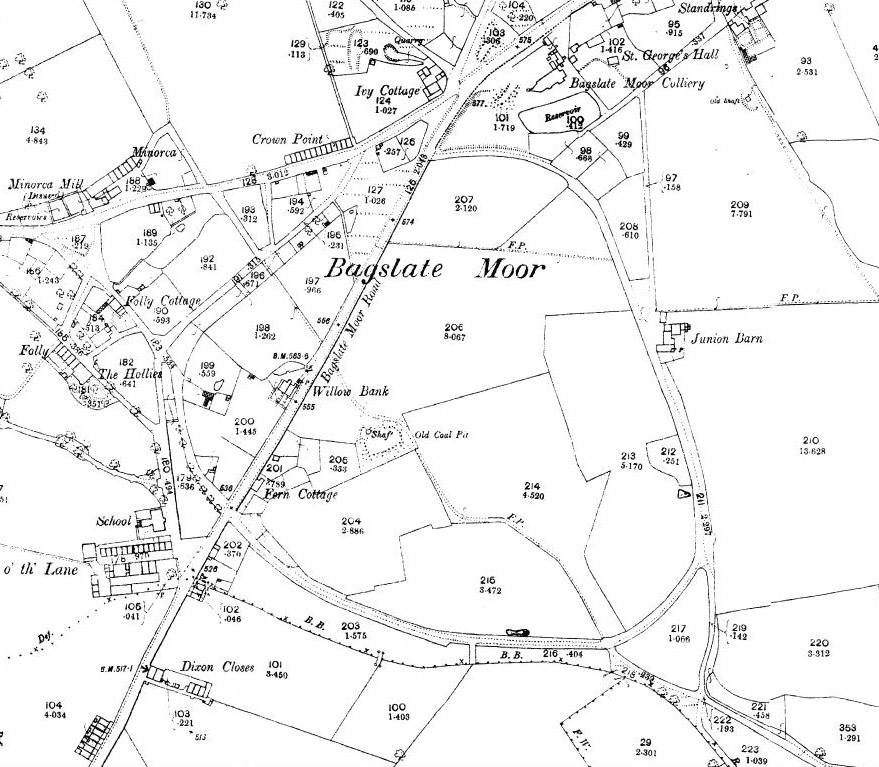Bagslate Races

Previous centuries have seen horse racing in Rochdale. The first was on Hunger Hill, later on Rooley Moor and then on Whittaker Moss south of Edenfield Road which must have been quite an organised occasion as a rudimentary grandstand on the site collapsed leading to the death of one Mary Sharples. After this, races were held on Bagslate Common where Rochdale Golf Course now stands. In the 19th century Bagslate was an important junction in the road out of Rochdale, being near to a turnpike on Edenfield Road for the route to Haslingden. Not only were political meetings held at Bagslate Moor (there had been a Chartist Camp there in the 1830’s), it was common to have it as the place for a fair with booths and huts rented out around which jugglers, tinkers, hawkers, toffee makers, pedlars, pickpockets and punters mixed with the crowd coming up from town. Part of the early fair featured a horse race with a £10 first and a £5 second prize.
Soon the site was established as a race course in its own right albeit rather old fashioned even for those days, with flights of hurdles and races taking place over three laps of the track.
Between the 1820’s and the 1850’s races were organised by the Rochdale Hunt, named by some the ‘Nudger Races’ after the leader of the hounds. The race meetings normally lasted three days, often at the beginning of July with prize money of £50 per race and special awards of The Manor and The Military Plates. Course discipline was initially strict from the stewards Edward Ball Esquire and Fred Lees Esquire in the 1820’s and from the Clerks of the Course Edmund Ogden or James Pilling who was also landlord of the Woolpack Inn at Marland. For example, dogs straying on the course would be destroyed immediately and gentlemen were advised not to ride on the course unless they were club members. Carts were allowed on the race course grounds but with a charge of 2/6d (12.5p) !
Visitors had to pay admission to the race meeting but once in, there was more than just horse racing and betting to while away the afternoon. Many of the fair’s legitimate booths and entertainments survived but alongside them there was cock-fighting, bull baits, dog fights, trail hunts and drinking and gambling on race days, the last public cock-fight being held in July 1828. Such activities sparked a great many objections to the race meetings. Certainly, the middle classes of Rochdale seemed to dislike these peripheral events. As one local paper put it, ‘all rapscallions and good for nawts descended on Bagslate.’ The Sunday Schools Union had particular objections and sent a representative group to the race committee to put a stop to it. Their meeting took place at the Woolpack Inn near to Toad Lane with John Ashworth claiming, after much prayer, that moral harm was coming to the townsfolk of Rochdale. The race committee promised to act to reduce the trouble that accompanied the racing. However, the meet went ahead although it rained so heavily that year that the horses found the going difficult. One horse named Bando, thought to have been an old post horse for the stage coaches that used to change at the Wellington Hotel, fell and was so badly injured it was shot on the spot, the story going that Bando’s skeleton was kept at Faukner’s smithy in town. This sad event further discredited the race meeting.
There is some suggestion that the races had been discontinued in the mid 1820’s but an article in Rochdale’s first newspaper, The Recorder, has it that the races were to be revived in 1827. Certainly by 1845 there was an appetite for racing on Bagslate Moor with a first grandstand being built to accommodate race-goers although no immediate payment was forthcoming to the builders. Notwithstanding that, a second grandstand was planned, so there must have been ambitions for further meetings. In fact, a foundation stone was laid for the new building and a Yeoman Band ‘just returned from Forin Parts’ as the newspapers had it, played as bottles of spirit were ceremoniously broken over the stone.
Through the 1840’s however, racing at Bagslate became more sporadic. Falling gate receipts meant smaller prize money and the field and the buildings where the races took place fell into disrepair. In 1850 the builder of the first grandstand James Pilling (who had also been Clerk of the Course) secured payment at last, but this had the effect of bankrupting the race club so once again the races were discontinued, the last meeting held in July 1850. Little is left of the Bagslate Races but not only can a colourful commemoration of them, ‘Hark to Nudger,’ be seen in Touchstones museum on the Esplanade but the Turf Tavern on Edenfield Road reminds passers-by to this day that Rochdale had once been a home to the so-called sport of kings.
